I’ve been thinking a lot recently. I know, it gets me into trouble a lot when I do that but I think I’ve finally figured out some things and it’s time to share. Let’s begin at the end, which seems fitting.
Over this last weekend I had the honor to give a demo and lead a workshop at a new bonsai boutique down Ft Lauderdale way, The Bonsai Supply: Thebonsaisupply.com
Thebonsaisupply.com
It’s run by a young couple, Jerome and Mariannjely. He is from Switzerland and she is from Venezuela.  Stole that pic off their Facebook.
Stole that pic off their Facebook.
The demo involved an interesting and difficult buttonwood.  Now, I’ll tell you a secret that only a few people knew: I was sick as a dog, an intestinal thing. I, as you may know if you’re a longtime reader, have a cyborg attachment to my lower GI tract and when I get any type of stomach bug I run the risk of a visit to the Emergency department for I. V. fluids. I think the sickness came from some bad iced tea ( my Brit readers are saying “serves you roight, ya’ bloody Yank, abusing tea that way!”). What I learned from the experience, if the tea tastes like coffee, don’t drink it.
Now, I’ll tell you a secret that only a few people knew: I was sick as a dog, an intestinal thing. I, as you may know if you’re a longtime reader, have a cyborg attachment to my lower GI tract and when I get any type of stomach bug I run the risk of a visit to the Emergency department for I. V. fluids. I think the sickness came from some bad iced tea ( my Brit readers are saying “serves you roight, ya’ bloody Yank, abusing tea that way!”). What I learned from the experience, if the tea tastes like coffee, don’t drink it.
Anyway, I tried my best with the tree, and I gave it a good start, I think. 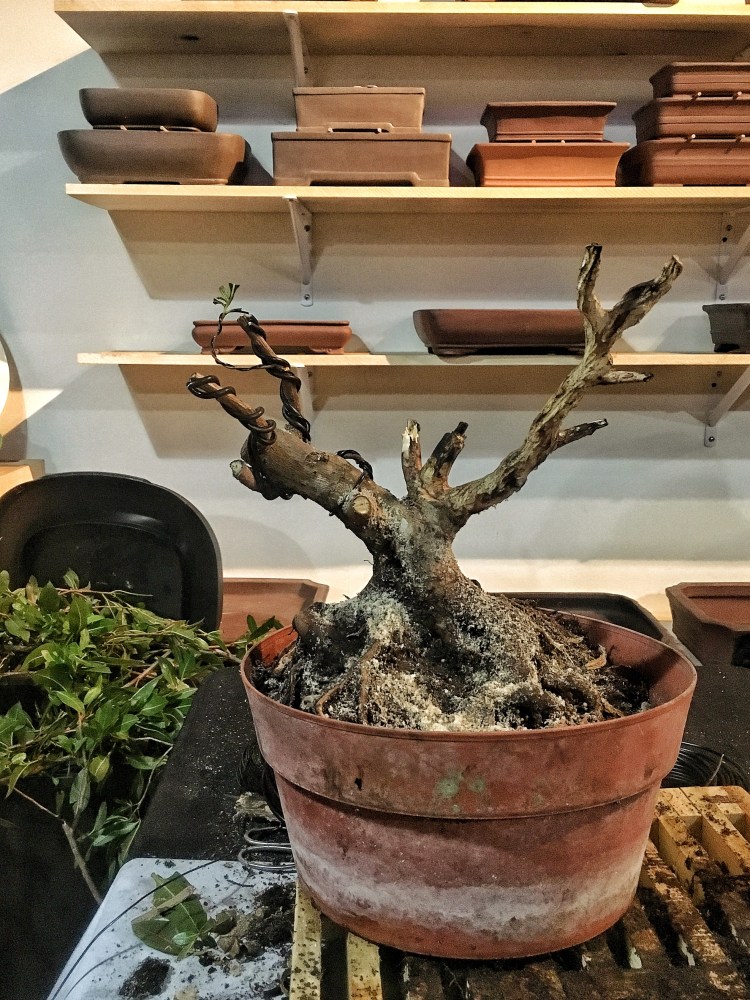 I added deadwood, wired a few branches, and there’s even a leaf or two left on it for identification purposes. My vision for the future:
I added deadwood, wired a few branches, and there’s even a leaf or two left on it for identification purposes. My vision for the future:
 But the tree above doesn’t really break rules, except that, as Mary Madison says, “it’s a buttonwood, it automatically breaks the rules”. Meaning that it’s a broadleaf tree with lasting deadwood. A big no no. But they do it naturally so you can’t really say anything. Ok, I guess you can but you’ll just make an ass of yourself with your ignorance. I’ll get in trouble with that last statement. They don’t call me “Troublemaker” for nothing, you know.
But the tree above doesn’t really break rules, except that, as Mary Madison says, “it’s a buttonwood, it automatically breaks the rules”. Meaning that it’s a broadleaf tree with lasting deadwood. A big no no. But they do it naturally so you can’t really say anything. Ok, I guess you can but you’ll just make an ass of yourself with your ignorance. I’ll get in trouble with that last statement. They don’t call me “Troublemaker” for nothing, you know.
So let’s get to the “rules”. I could list them but they are everywhere you want to look. If you put a tree on any of the Facebook Bonsai pages or on Bonsainut and all those forums you’ll be bombarded with them. I’ve never called them rules myself. Here’s my story to explain why: I’m an artist, a painter, sculptor, I can draw and all that. And I’m trained in it. I know about proportions, structure and vanishing point theories, color theories and use to show light and dark and foreground/background differences. I understand composition, positive/negative space, line shape and form. If you were trained in that properly or studied it then you understand what I’m talking about. Most bonsai people were not. When I first started, and I love this story, I was explaining negative space to an intermediate (at the time) and they’d never heard the term.
But Art, ever since the invention of the camera, has been in flux, trying to find its way. All the concepts were formed as far as technique, a painter could paint a realistic depiction of whatever they wanted; a tree, a portrait, a bear, a girl, a bare nekkid girl. The techniques were formalized and repeatable. But they weren’t rules, even then, except in the case that, when you were an apprentice, you painted like your teacher because it was technically his work, so you followed his rules, until you went on your own. No, really, apprentices had no intellectual rights to their own work. There are serious and heated debates about many Renaissance painters works and if it was painted by this or that apprentice or how much. This was because art was a business and a craft that people associated with a specific artist. This practice is, technically, still legally binding, but not enforced much; if you’re in college, your professor could claim your work as his and you get screwed.
With the invention of the camera, which could reproduce anything and by anyone, art, or, Art, had to adapt. This gave birth to the idea of “Art for Arts sake”. Instead of being a craft that reproduced something, the artist had more freedom to express ideas, or concepts. This freedom is perfectly illustrated by the works of the Impressionists. There were scientific concepts that they used when painting that explained their works but they were not realistic in the same way as the past painters thought of realism. The colors weren’t mixed on a pallette but applied straight onto the canvas, next to each other, and the viewers eyes “mixed” them. So you put a yellow blob next to a green blob and the eye or brain gave you green. That was the concept behind Impressionism, the painting of light (white light is made up of colors that objects then either absorb or reflect, which, then, enters the eye and the brain sorts it all out). There was also a change in the narrative of paintings. Previously, paintings illustrated a story or biblical passages, or there were specific portraits of people commissioned for that purpose. In the new Art, the subject was secondary to the exploration of the new concept. A painter didn’t paint a portrait of a person to reproduce the image (which was done better by a photo) they painted a portrait to explore an idea or technique. These new works challenged the status quo so much that the painters, like Monet, Pissarro, Degas and all the rest, were refused entrance into the annual exhibit sponsored by the French government. Talk about rude, huh?
So what’s this to do with bonsai? Let’s take one “rule”. It’s the concept of proportions: How tall should a bonsai be? The current proportions are 1:6. The one is the width of the trunk, the six is the height of the tree. So you have a tree with a one inch trunk, the height should be six inches tall. Easy, right? These proportions are supposed to help illustrate a more natural looking tree, even though in nature the proportion is closer to 1:10 or so, depending on the type, age etc of the tree. Don’t believe me? Go measure. I’ll wait……..
Told you so. So how is this a rule at 1:6 then if naturally it’s 1:10? Easy, the more a proportion is exaggerated, the more a thing might look bigger, more stout, taller, or more delicate. By shrinking the proportion to 1:6 or even 1:4 or, in an extreme case, 1:1, it makes the tree seem more huge and, more importantly, older. Just like us, as we get older we get fatter, but the height doesn’t change. So the more close that ratio is, the fatter a tree looks. (There’s also the concept of a close view or a far away view. Like looking at a tree on a mountain ridge might have the ratio of 1:12 or a tree that you are one foot away from seems like a ratio of 1:1, those are visual tricks we artists can play on the viewer). But is all this a rule? No, it’s called a principle. And it has to do with design and what you are trying to convey. A near or far view? An old tree or an ancient tree? A young tree? The things that the Bonsai police call rules are simply design principles to help us to create bonsai. Here’s a cedar elm I worked on in New Orleans. It breaks the proportion rule.  There’s little taper too. But it looks like a tree, even an old tree, because I made the branches twisted and old looking. It doesn’t look much like a bonsai unless you think bonsai should look like trees. I think they do. Remember, Bonsai is the Art of making young little trees look like big, old trees.
There’s little taper too. But it looks like a tree, even an old tree, because I made the branches twisted and old looking. It doesn’t look much like a bonsai unless you think bonsai should look like trees. I think they do. Remember, Bonsai is the Art of making young little trees look like big, old trees.
Which brings us to a question that haunts the corners of clubs, the depths of forums and internet groups, simply put: Is Bonsai Art? Let me post some pics, those glazing over the text are getting bored.
This greets you when you first walk into the Bonsai Supply. 
This is Jesus. His wife bought him the shirt. He’s on the phone with her saying “I’m on my way home honey, promise!” 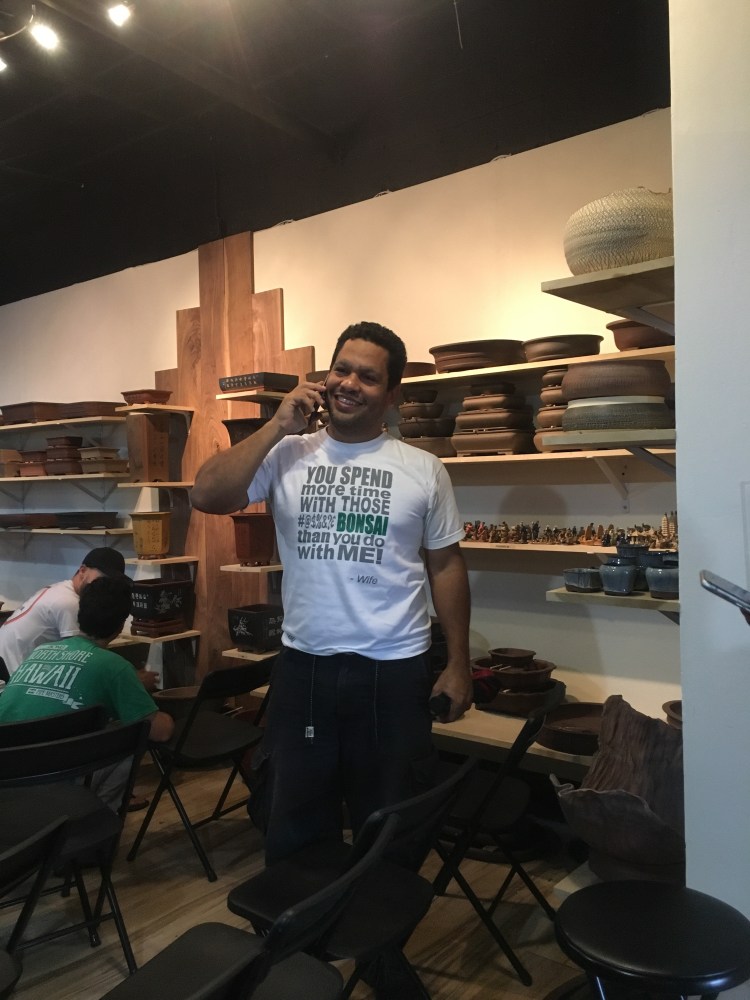
Me contemplating the tree that really catalyzed this blog post. Today’s subject: a portulacaria afra.  All photos following, with me in them, are by Matt Cioffi.
All photos following, with me in them, are by Matt Cioffi.
Ok, let’s set a scene, there I am, in a neat little bonsai shop, sick and delirious, contemplating this mass of a portulacaria with a hydra head of branches engulfing the trunk. I get to work, trying to make this little, relatively young tree look like an old, big tree (See what I did there? I just defined what a bonsai is……pay attention, I’m just going to throw those kinds of things into the narrative…).
I raise my scissors and begin the hack job. 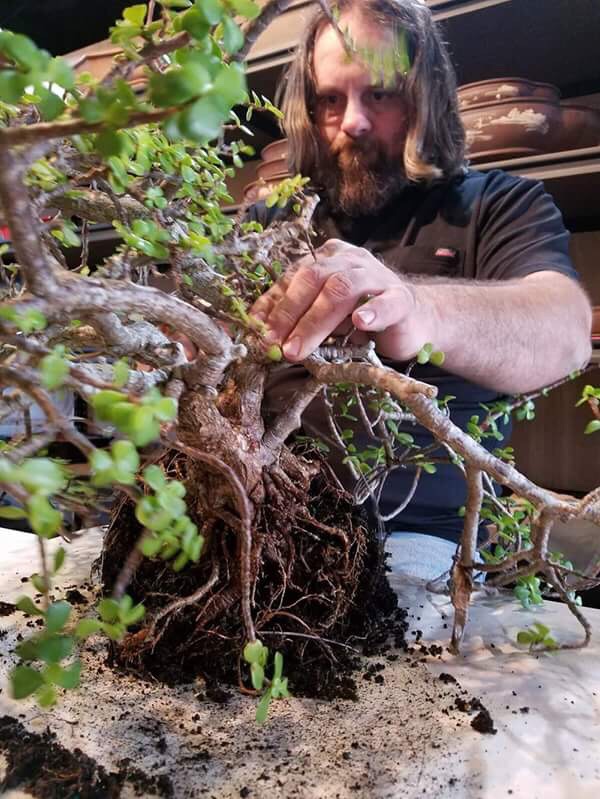
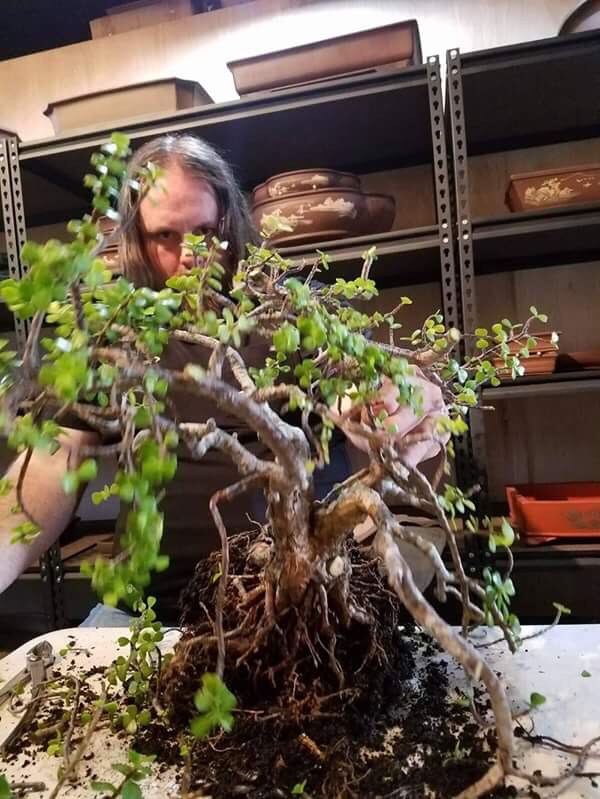 I am intent on preserving those gnarly, twisted branches. They really begin to age a tree when they’re getting movement like that. In my younger days I may have chopped the tree back. Way back. Maybe here:
I am intent on preserving those gnarly, twisted branches. They really begin to age a tree when they’re getting movement like that. In my younger days I may have chopped the tree back. Way back. Maybe here: 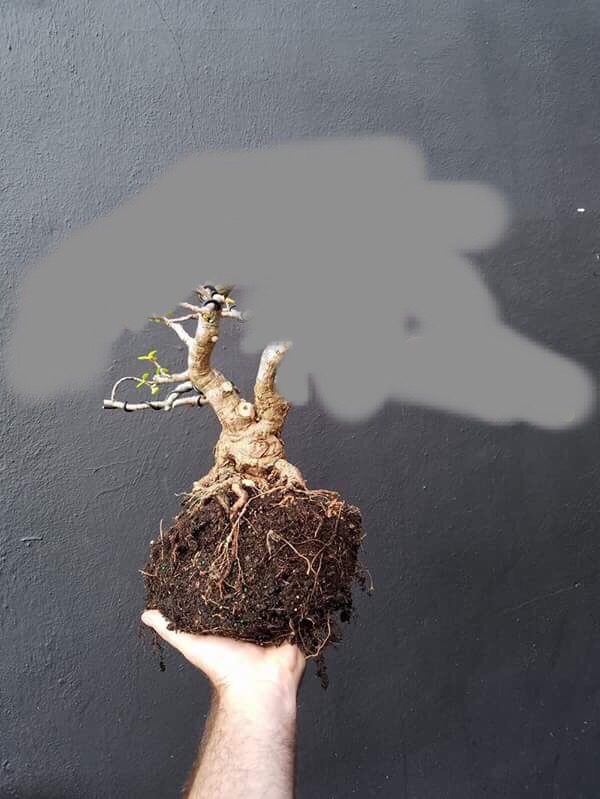 or even way back here:
or even way back here: Just so I could create the perfect trunk line and taper and get the branches to grow where they need to be.
Just so I could create the perfect trunk line and taper and get the branches to grow where they need to be.
But in my delirium, I saw the tree as it could be. So I took my time, chiseling away like a headstone mason, not wanting to make an errant chip on a monument that is meant for eternity. 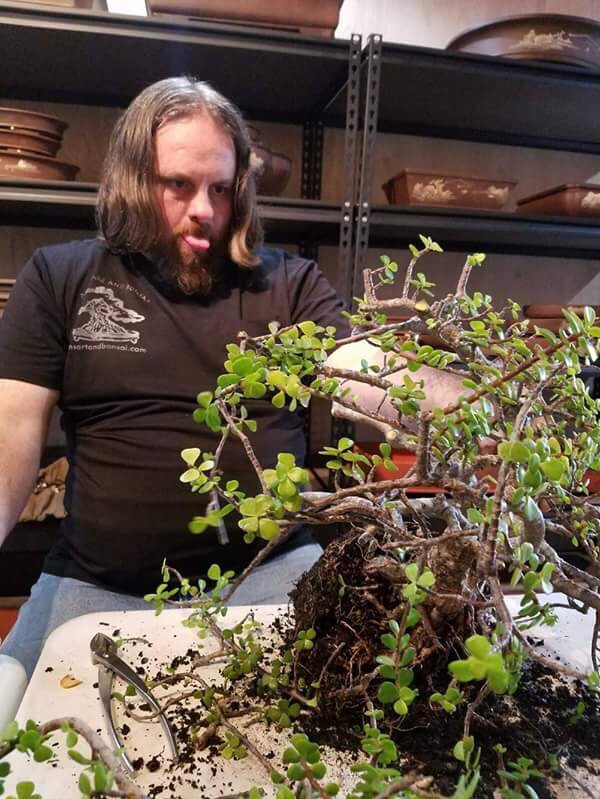 When I was a younger man, I painted a portrait of a friend, named David Johnson. The canvas was huge, 60″x60″. He didn’t stay friends long, he was jealous of my long, flowing locks, my cunning linguist skills, my obvious artistic genius, and I might have stolen his girlfriend at prom. But one thing that cemented his hatred of me was my propensity to stick my tongue out when I worked.
When I was a younger man, I painted a portrait of a friend, named David Johnson. The canvas was huge, 60″x60″. He didn’t stay friends long, he was jealous of my long, flowing locks, my cunning linguist skills, my obvious artistic genius, and I might have stolen his girlfriend at prom. But one thing that cemented his hatred of me was my propensity to stick my tongue out when I worked.  It’s a facial tic that helps my brain to focus.
It’s a facial tic that helps my brain to focus.
Or I just do it to annoy people. One of the two, I can’t tell sometimes.
 Anyway, the process, which was going on during the workshop and I was spending too much time on, and ignoring the other students as a result, was advancing slowly.
Anyway, the process, which was going on during the workshop and I was spending too much time on, and ignoring the other students as a result, was advancing slowly. 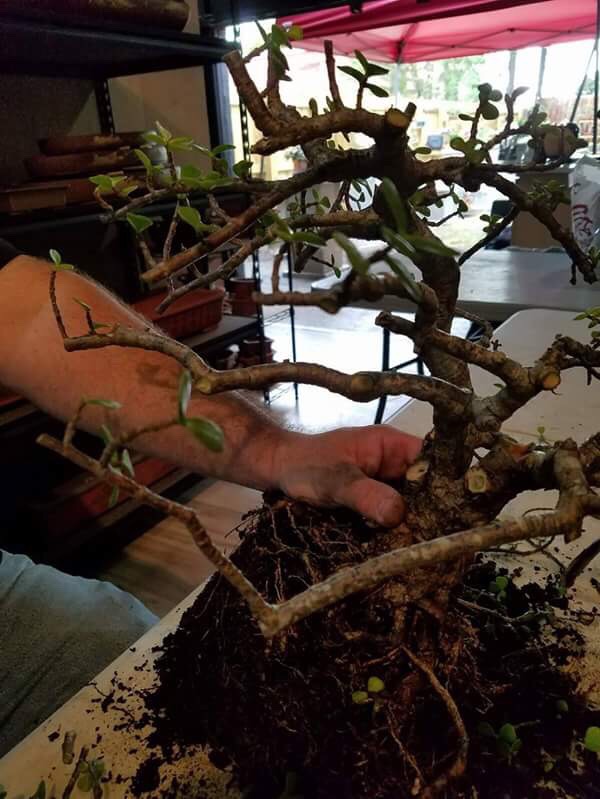 But I was seeing the end, so to speak (to which those readers who’ve invested all this time reading a weird post, are wishing I would arrive at, already, an ending….)
But I was seeing the end, so to speak (to which those readers who’ve invested all this time reading a weird post, are wishing I would arrive at, already, an ending….) I am almost ready for wire.
I am almost ready for wire.  As you can see from an aerial view, I am saving a lot of branches that may not follow the rules.
As you can see from an aerial view, I am saving a lot of branches that may not follow the rules. 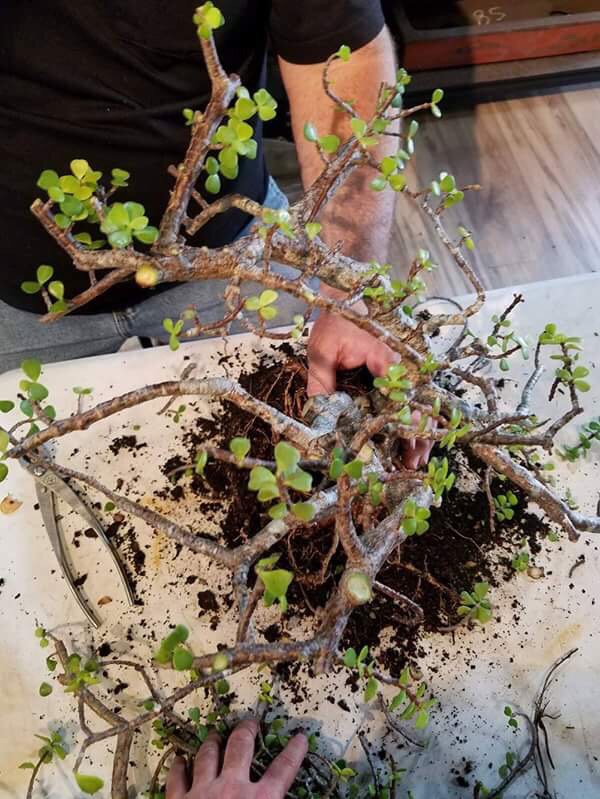
 That’s Matt’s hand btw. You can tell by how small and clean it is compared to mine. There were several more trees I worked on at the class. Here’s a Link to see some of them.
That’s Matt’s hand btw. You can tell by how small and clean it is compared to mine. There were several more trees I worked on at the class. Here’s a Link to see some of them.
So what is the realization I came to in my delirium? That one learns the rules not to break them but to use them. Not only using them in your trees and in making them look old but to learn when to ignore them when it furthers the goal, old trees.
And the status quo be damned. I’ve participated in many shows and exhibits but I don’t care if I win awards. I show my trees and displays as Art. But in the shows, it’s not innovation or new ideas that win, it’s a preservation of “What has come before”. And shit, it’s sometimes even a celebration of the mediocre. There are shows with multiple Judges where each judges choice for best tree is removed from the running and only the second best trees are then up for awards (I’ll get in trouble for that statement too. I realize that the idea behind it is to remove favoritism and politics but it doesn’t really work out that way. So you either have the best trees by score removed or the judges lie about their scores so their real best tree is their 2nd choice. Personally I’m against a judge using a numbers based scoring method, where a tree gets so many points for roots spread, movement, branching etc. I’m more of a feelings kind of guy. If I like the tree then that’s what I pick).
I guess I’m just a rebel. Here I am at a protest I really believe in. 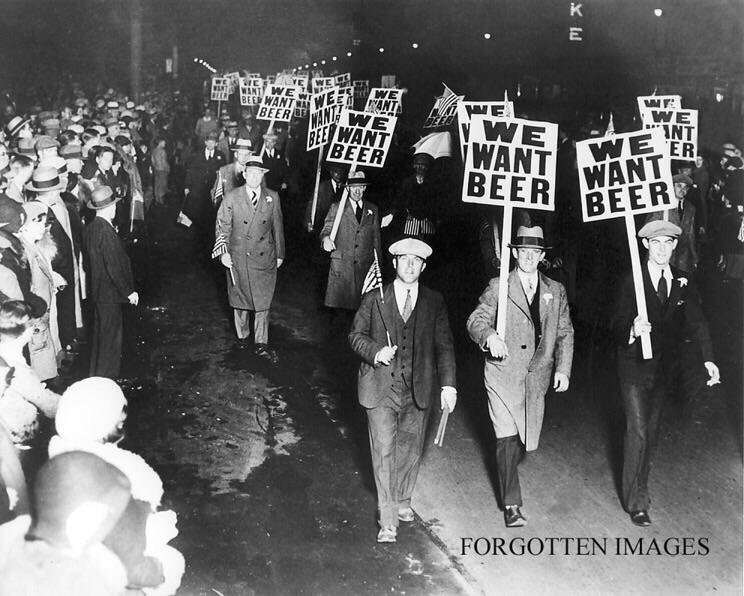 See me in the back? Passed out in the gutter.
See me in the back? Passed out in the gutter.
But I’m a grateful rebel. Here’s a pic of the guys from the workshop. 
Thank you Mari, Jerome, Matt (especially Matt, for the jade, which he gave to me as a gift). Thanks to the audience for laughing at the bad jokes, the students who let me chop their trees up and thanks to Jose, for making sure I didn’t die (he’s the guy on the left with the pineapple on his shirt).
Oh, the jade all potted up. I like it. 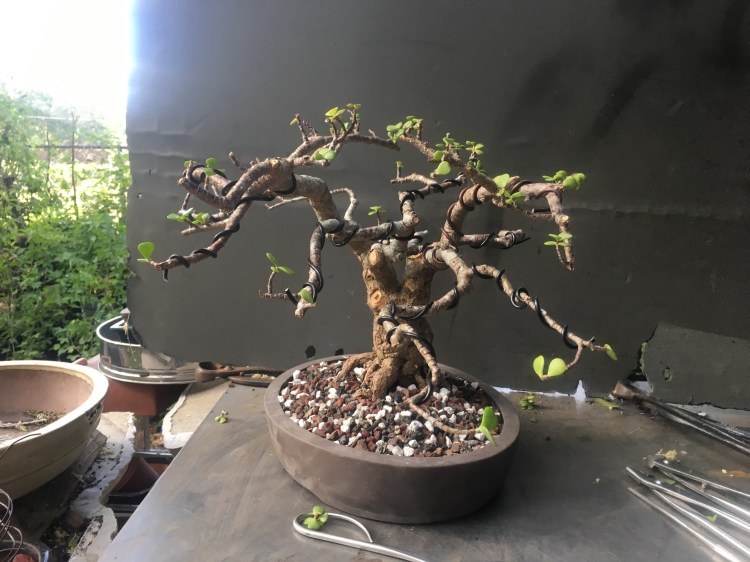

It might win an award in the future. Not today though. It does look old, right? I like to call it the Hanging tree style.

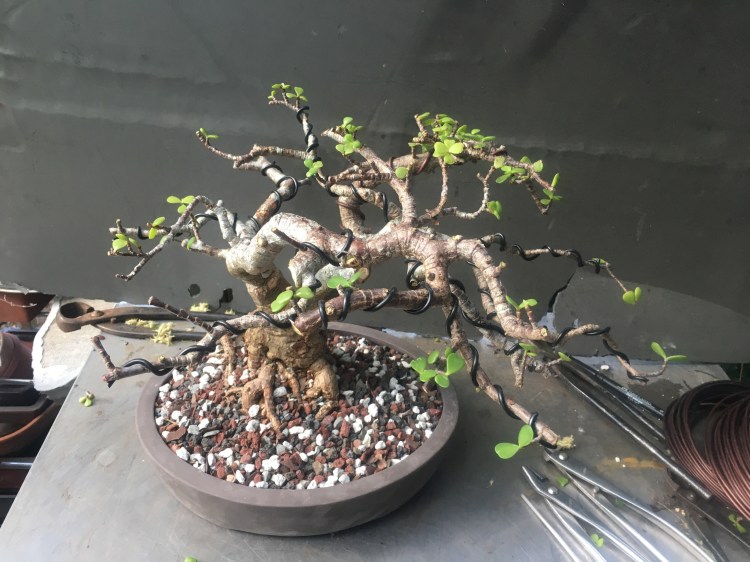

I like your portulacaria…I like your post….I think the best tree is the one I want to go look at some more…. slowly…….
LikeLiked by 1 person
Just thought you’d like to see a picture of my newest acquisition….
It’s a Green Prince Lebanese Cedar, (*Cedrus libani *’Green Prince’).
I am a rank amateur at best in the world of bonsai, but as a Certified Arborist some of your rule breaking appeals to me. Many of the “rules” of bonsai that I have read run counter to a lot of what I have learned in Arboriculture and tree physiology.
Thanks!
Lydia Ruddy
adamaskwhy posted: “I’ve been thinking a lot recently. I know, it gets me into trouble a lot when I do that but I think I’ve finally figured out some things and it’s time to share. Let’s begin at the end, which seems fitting. Over this last weekend I had the honor to “
LikeLike
Reblogged this on Wolf's Birding and Bonsai Blog.
LikeLike
I admire your work but two questions:
1. What rules did you break?
2. Why call it “Hanging” tree? I don’t see a noose…
LikeLike
I think it was because it looks like a tree that a hanging might occur under. During the olden days trees with low branches like that were often used for the administration of capital punishment.
LikeLike
I believe making Bonsai is an art. Bonsai maker is not less than an architect. That is you. Thanks a lot.
LikeLike
Yeah but architects can design those huge cantilever branches…cool tree!
LikeLike